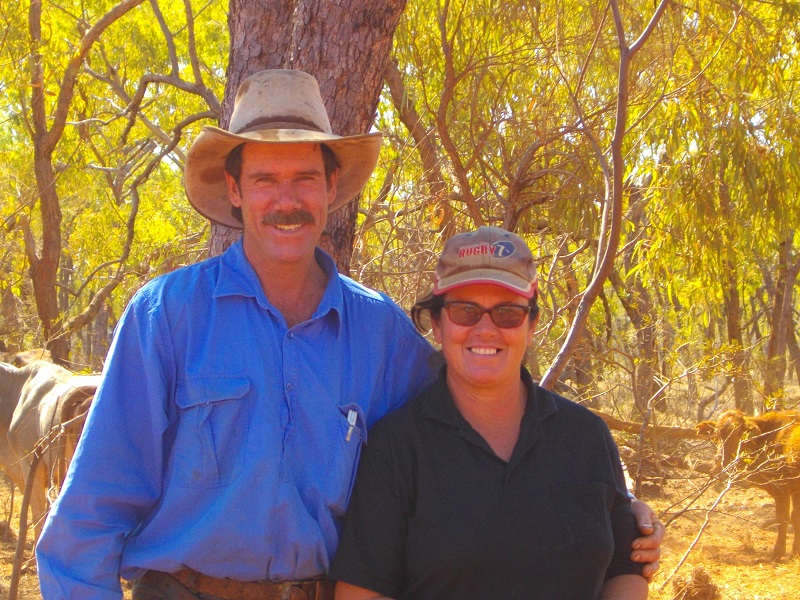
Dennis Donohoe, farm manager with Aminya Pastoral, is a seasoned producer with decades of experience, and his story is a testament to how even minor changes in farming practices can lead to significant improvements in productivity and land health.
Location: South of Torrens Creek, 340 kilometres West of Townsville, North Queensland
Property size: 31,000 hectares
Currently runs: 1400 LSU
Average annual rainfall: 500mm
Enterprise: Beef cattle breeding
Achievements:
Drivers of Success:
Ideas for future innovation:
RCS services used:
Bunuro is a beef cattle farm south of Torrens Creek and west of Townsville, sprawling over 31,000 hectares. Since 2001, under the forward-thinking ownership of owners David and Donna Rankine, the farm has converted into a viable cattle business that is ecologically sustainable.
The Rankines have implemented management techniques such as rotational grazing, single-wire electric fencing and a reticulated water system to reduce grazing pressure at water points and give paddocks long rest periods. Despite the challenges of the property, the Rankines are excited to see the future potential.
David and Donna believe a sustainable business has stable ecological health and is economically viable. The Rankines met Terry McCosker at a grazing information session in Pentland and began implementing regenerative grazing practices after the purchase of Bunuro.
They started slowly, with grazing rotations utilising existing fences and water, and gradually gained experience with rotational grazing. In 2002, they received funding for a pipeline and ran it down a fence along the road between the clean and heart-leaf country. This means that grazing pressure is well distributed, and regular rotations result in plenty of available feed and minimal losses to the poison produced by the heart-leaf plant.
David and Donna were determined to own their land and pioneer these new practices in the area and wanted to manage it in a way that was improving rather than degrading ecosystem health. David and Donna completed GrazingforProfit® in 2002 and began ExecutiveLink® in 2004, leading to the purchase of quality cattle at an affordable price. Since graduating from ExecutiveLink®, they have also completed a Low-Stress Stockhandling School (LSS) and were involved in the Climate Champion program.

The Rankines are managing the land effectively and positively influencing the environment, despite the challenges associated with beef production. Innovations include rotational grazing, single-wire electric fencing, telemetry, tractor tyres on concrete slabs for troughs, and water development. All of these innovations have saved the Rankines time and money.
The stock watering system is fully reticulated, pumping from one bore and distributed to over 90 kilometres via a 63mm poly pipe. They have installed five dams on the property and 60 troughs made of tractor tyres, saving significant costs in water development.
Reliable stock watering systems are an important tool toward sustainability, and the Rankines are maintaining high levels of ground cover despite numerous poor seasons. The business is managed as a low-input system to ensure long-term viability.
The Rankines have developed a key innovation at Bunuro to muster the whole mob of cattle without the use of a helicopter. To do this, they have set up multiple troughs in each paddock. A second trough is installed at the front of the paddocks, approximately 50 metres away from the central trough, and the cell centre is closed off when cattle move out of the paddock. This results in an easy, efficient and highly cost-effective clean muster.
David and Donna are also reducing the use of fire where possible, as burning Spinifex country exposes a lot of bare ground, and animal impact followed by paddock rest successfully promotes nutrient cycling. They have also observed that wattle is encouraged by fire, and without fire, the wattle naturally peaks and then diminishes after approximately five years.
The biggest achievement for the Rankines is that they can see they have developed something from nothing, which is maintaining ecosystem health. The family has made key observations since 2001 that show they are improving the land at Bunuro. This includes increased ground cover, pasture growth and resilience, increased carrying capacity, desirable species, and greater biodiversity.
David and Donna have created their own Grazing Chart spreadsheet to monitor feed availability and feed consumed in each paddock. Completing property development was significantly easier with funding from NRM groups and government bodies. Their overall results with regenerative farming methods include:
The Rankines aim to run as many cattle as possible while improving the land’s quality and utilising the heart-leaf country to its maximum capacity. They plan to continue the current grazing management system and measure increases in production with Stock Days per Hectare, the number of Large Stock Units (LSU) sustainably managed and overall grass quality.
David and Donna aim to use water medication to reduce the expense of supplementary feeding. They are passionate about research and are willing to support studies that help move the industry forward. Their ideas for future innovation include:
The Rankines have taken on a challenge and made inspiring long-term improvements to the property and ecosystem in one of the more challenging areas to produce beef. To be sustainable, graziers must have stable markets, a more substantial price for beef, and access to education.
Profitable Paddocks is our educational newsletter sent to your email inbox every quarter.
Click the Bell for the latest blogs.

Dennis Donohoe, farm manager with Aminya Pastoral, is a seasoned producer with decades of experience, and his story is a testament to how even minor changes in farming practices can lead to significant improvements in productivity and land health.
Once you have ownership as to why planning is important, the next ingredient is to work out where and how you will do your planning. When you write something down you change your relationship with the content. I cannot emphasise enough the power of getting your thoughts and plans out of your head onto paper or the computer.
The season in SA and Tassie is particularly tight right now with little or no useful rain since early January and a generally failed 2023 spring prior to that. Right now, across southern Australia and much of the eastern NSW, you won’t need to drive far out into the countryside to see cattle and sheep grazing (and lying on) hay and silage trails lined across paddocks.
Martha Lindstad and partner Robert James are farm managers on ‘Karalee’, Enngonia NSW. Both have travelled different paths to being where they are. Martha is originally from Norway, growing up on a three hectare farm before travelling to New Zealand and eventually the Pilbara in Western Australia. It was here that she saw the benefits of sustainable farming for the country and livestock.
The Prince’s RCS mentor, Raymond Stacey, sees a strong future ahead for Simon and Laura. “The Drought Resilient Soils and Landscapes project is about supporting graziers to manage their country and businesses better,” Raymond said. “I see an operation here where they’re working hard on their planning and putting their plans into action to leave their country, business and people in better shape.”

Join our mailing list
